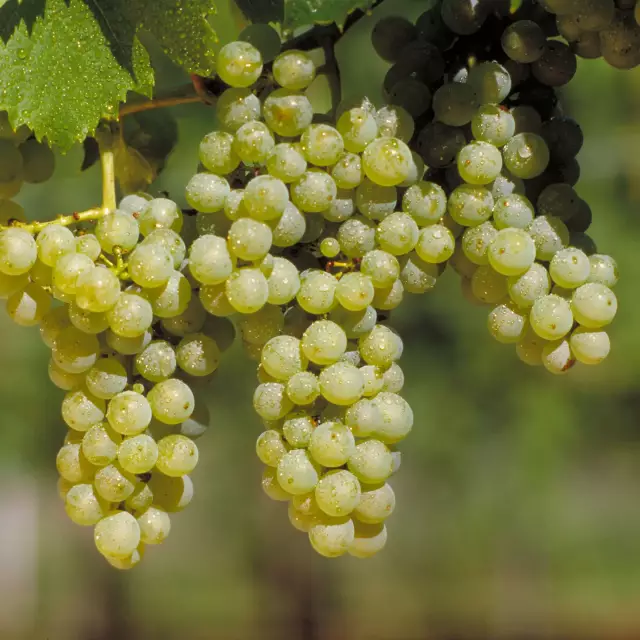Müller-Thurgau

Created in 1882 in Geisenheim by Professor Hermann Müller from Thurgau in Switzerland from a cross of Riesling x Madeleine royale, Müller-Thurgau is now the second most important white grape variety in German viticulture after Riesling.
Facts
-
10.738 ha
Vineyards in Germany 2023
Cultivation
Müller-Thurgau vines cover 10,738 hectares (2023) in almost all German wine-growing regions. The largest areas were found in Rheinhessen with approx. 3,834 hectares and in Baden with approx. 2,160 hectares, followed by the Palatinate with approx. 1,591 hectares, Franconia with approx. 1,375 hectares and the Moselle with approx. 743 hectares. The restriction of permissible yields per hectare of vineyard introduced in the 1980s has had a very positive effect on Müller-Thurgau in particular, which tends to produce high yields. The variety shows its true quality potential with lower pruning.
Significance
In the German wine landscape, Müller-Thurgau relinquished its leading position to Riesling in the 1990s. However, with an area share of about 10.6%, the grape variety still has an outstanding importance in German viticulture. The fact that Müller-Thurgau now grows on almost 11,000 hectares is due, among other things, to its many uses and its accessibility even to non-wine connoisseurs. In addition, the Müller-Thurgau grape is not very demanding in terms of location and is considered to have a high yield.
Vinification and taste
The grape variety ripens early and produces drinkable, sometimes flowery wines with a delicately fruity muscat aroma. The acidity tends to be mild, sometimes more pronounced in wines of northern origin. The wine is usually matured in stainless steel tanks, which are good for preserving the freshness and varietal aroma. Most of the wines are dry or residually sweet quality wines. With some exceptions, Müller-Thurgau is not a storable wine and tastes best in the first few years after harvesting. Here and there, "sur lie" wines are also offered, which lay on the fine lees until shortly before bottling.
The wines are easily accessible in taste and are popular because of their harmonious character. They are pale yellow to light yellow in colour and have a medium body. If they bear the designation Rivaner on the label, one can assume that it is a dry, rather youthful, light and fresh wine. Müller-Thurgau wines are usually uncomplicated everyday wines that harmonise well with delicately aromatic dishes.
History
The grape variety owes its existence and name to Professor Hermann Müller from the Swiss canton of Thurgau. Müller, who lived from 1850 to 1927, bred this grape variety at the Geisenheim Research Institute. Recent genetic studies indicate beyond doubt that he succeeded in doing so by crossing Riesling x Madeleine royale. The variety was further developed at the Swiss research institute in Wädenswil and named after its breeder in 1913. The synonym Rivaner is a short version of the words Riesling and Silvaner. These two varieties were long considered the parents of Müller-Thurgau.
At a glance
- Breeding from a cross between Riesling x Madeleine royale
- occupies about 15 % of the white vineyards in Rheinhessen
- high-yielding and early ripening
- Aroma: delicately fruity-floral, delicate herbs, apples or pears.
What does Rivaner have to do with Müller-Thurgau?
The name Rivaner is composed of the varieties Riesling and Silvaner, which were long considered the parents of Müller-Thurgau.
(artificial potted meat) in the style of the house "Kunschthäwwelfläsch"
(artificial potted meat) in the style of the house
- 1 kg Schweinekamm
- 2-3 ganze Zwiebeln
- nach Belieben Lorbeerblätter, ganze Nelken, gemahlener Kümmel, Pfefferkörner
- 500 ml Rivaner oder Silvaner
- nach Geschmack Salz & Pfeffer
A few days before preparation, have a piece of pork neck picked up from the butcher. Alternatively, salt and pepper the pork neck yourself before preparation. The day before, cut into the pork neck with a sharp knife at a distance of approx. 1.5 cm, but do not cut all the way through.
Peel 2-3 onions, halve and cut into rings. Prepare the bay leaves, cloves, caraway seeds and pepper. Place a few slices of onion, a clove, some ground cloves and pepper in the incisions and a bay leaf in every other incision. Place the remaining onions, one or two cloves and a bay leaf in a large roasting tube, place the meat on top and pour in the white wine. Close the roasting tube tightly and leave the meat to marinate overnight in the fridge.
Then place the roasting tube on the cold oven rack and cook for approx. 1½ to 2 hours at 200 °C (gas mark 4, fan oven 180 °C).
- Müller-Thurgau (halbtrocken & feinherb)
- Silvaner (halbtrocken & feinherb)





